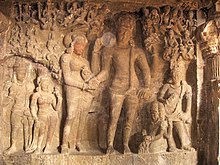OM Shanti OM
(New : You can now listen to Om. See download details below )
OM or AUM is the most important and significant word of Mantra tradition. It is considered as the root mantra of all mantra. In a majority of Mantra, you will find OM.
OM is the most often chanted sound among all the sacred sounds on earth. This sound is considered as the sound of the existence.
it is believed that the whole universe, in its fundamental form, is made up of vibrating, pulsating energy. Om is considered as the humming sound of this cosmic energy.
OM is said to be the original primordial creative sound from which the entire universe have manifested. It is also known as the 'Anahat Nada', the "Unstruck Sound". This means the sound that is not made by two things striking together.
If you observe the nature of sound you'll find that all ordinary audible sound are produced by the striking of two objects : bow and strings, drum and stick, two vocal cords, waves against the shore, winds against the leaves, bat against the ball, tyers against the road etc. In short all sounds within our range of listening are produces by things visible or invisible, striking each other or vibrating together, resulting in pulsating waves of air molecules which we interprets as sound.
In contrast to the above, OM is the sound which is not the result of the striking of two objects. It, rather emanates on its own. It is the primal sound of the universe that contains all sounds in itself.
The meaning of OM
Well unlike all other mantra, there is no meaning of OM. It is actually not a word, it is a sound. As per Hindu tradition, OM is the purest name of God. It is the sound of the supreme consciousness. So when you reapeat OM, you actualy take the name of God.
Now without going into the further philosophical explanation of OM, let us learn how to meditate using OM. Repetition of OM or AUM dissolves the mind it its divine source. The chanting of OM several time loud, purifies the atmosphere.
Sit in a comfortable undisturbed place. Take some deep breath. Now chant at least 7 times OM in succession. Make each breath last as long as possible. Teak deep breath and chant Oooooooo~~~~~hhhhhhhhhh~~~~~ Mmmmmmm~~~~~. Then again repeat this chanting of OM. Do this for 7 times. After this, stop chanting and sit for a moment of silence. You will be amazed by the inner peace you'll get in such a small chanting of OM.
Listen the sound of Universe : Let us listen the sound of OM. You are requested to listen carefully. This sound of OM produces instant positive vibrations and takes the listener to a state of mental stillness.
Chanting the OM mantra for 15 minutes daily can produce remarkable effect in you. This mantra will help you to calm the mind, settled the thought process and realize the self.
.
Listen to OM now !!
Download this small (just 164 KB) mp3 file of OM. Listen to this powerful vibrating sound of Universe now.
It's a very small file and you can listen to it within seconds.
(if you click with your left mouse button, it will directly play the file)
(if you click with Right mouse button you'll be prompted to save the file. Save it in your hard disk)
After downloading it, play it on your favorite media player and switch on the repeat button. It'll keep repeating itself. Enjoy !.
(Please note: Very important ! Don't listen to Om while you are busy (for example while driving or doing important tasks requiring mental effort). Stop listening it if you feel uneasy. Not recommended for heavy meat eaters)

























